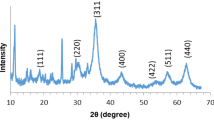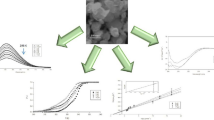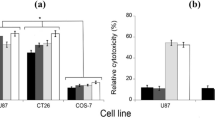Abstract
In order to study the mechanisms underlying the effects of TiO2 nanoparticles on lactate dehydrogenase (LDH, EC1.1.1.27), Institute of Cancer Research region mice were injected with nanoparticulate anatase TiO2 (5 nm) of various doses into the abdominal cavity daily for 14 days. We then examined LDH activity in vivo and in vitro and direct evident for interaction between nanoparticulate anatase TiO2 and LDH using spectral methods. The results showed that nanoparticulate anatase TiO2 could significantly activate LDH in vivo and in vitro; the kinetics constant (Km) and Vmax were 0.006 μM and 1,149 unit mg−1 protein min−1, respectively, at a low concentration of nanoparticulate anatase TiO2, and 3.45 and 0.031 μM and 221 unit mg−1 protein min−1, respectively, at a high concentration of nanoparticulate anatase TiO2. By fluorescence spectral assays, the nanoparticulate anatase TiO2 was determined to be directly bound to LDH, and the binding constants of the binding site were 1.77 × 108 L mol−1 and 2.15 × 107 L mol−1, respectively, and the binding distance between nanoparticulate anatase TiO2 and the Trp residue of LDH was 4.18 nm, and nanoparticulate anatase TiO2 induced the protein unfolding. It was concluded that the binding of nanoparticulate anatase TiO2 altered LDH structure and function.







Similar content being viewed by others
References
Oberdörster G, Oberdörster E, Oberdörster J (2005) Nanotoxicology: an emerging discipline evolving from studies of ultrafine particles. Environ Health Perspect 113:823–839
Warheit DB, Hoke RA, Finlay C, Donner EM, Reed KL, Sayes CM (2007) Development of a base of toxicity tests using ultrafine TiO2 particles as a component of nanoparticle risk management. Toxicol Lett 171:99–110
Afaq F, Abidi P, Matin R, Rahman Q (1998) Cytotoxicity, pro-oxidant effects and antioxidant depletion in rat lung alveolar macrophages exposed to ultrafine titanium dioxide. J Appl Toxicol 18:307–312
Oberdörster G, Finkelstein JN, Johnston C (2000) Acute pulmonary effects of ultrafine particles in rats and mice. Res Rep Health Eff Inst 96:5–74
Wang JX, Zhou GQ, Chen CY, Yu HW, Wang TC, Ma YM, Jia G, Gao YX, Li B, Sun J, Li YF, Jia G, Zhao YL, Chai ZF (2007) Acute toxicity and biodistribution of different sized titanium dioxide particles in mice after oral administration. Toxicol Lett 168:176–185
Liu HT, Ma LL, Zhao JF, Liu J, Yan JY, Ruan J, Hong FS (2009) Biochemical toxicity of nano-anatase TiO2 particles in mice. Biol Trace Elem Res 129(1):170–180
Liu HT, Ma LL, Zhao JF, Liu J, Yan JY, Ruan J, Hong FS (2009) Toxicity of nano-anatase TiO2 to mice: liver injury, oxidative stress. Toxicol Environ Chem (in press). doi:10.1080/02772240902732530
Ma LL, Zhao JF, Wang J, Duan YM, Liu J, Li N, Zhao jF, Ruan J., Hong FH (2009) The acute liver injury in mice caused by nano-anatase TiO2. Nanosacle Res Lett (in press). doi:10.1007/s11671-009-9393-8
Keesey J (ed) (1987) Enzymes for routine quantitative analysis. In: Biochemica information. Boehringer Mannheim, Indianapolis, p 46
Iwata S, Kamata K, Yoshida S, Minowa T, Ohta T (1994) T and R states in the crystals of bacterial L-lactate dehydrogenase reveal the mechanism for allosteric control. Nat Struct Biol 1:176–185
Letner C, Alter G (1996) Molecular dynamics of local protein motions in lactate dehydrogenase. J Mol Struct (Tbecchem) 368:205–212
Wang JY, Zhu SG, Xu CF (2002) Biochemistry. Higher Education Press, Beijing, p 356, 362, 428 (in Chin)
Yang P, Lu C, Hua N, Du Y (2002) Titanim dioxide nanoparticles co-doped with Fe3+ and Eu3+ ions for photocatalysis. J Mater Sci Lett 57:794–801
Wotton IDP (1964) Enzymes in blood. Microanalysis in medical biochemistry. Churchill, London, pp 101–118
Labrou NE, Clonis YD (1997) Simultaneous purification of L-malate dehydrogenase and L-lactate dehydrogenase from bovine heart by biomimetic-dye affinity chromatograph. Bioprocess Eng 16:157–161
Turoverov KK, Shchelchkov BV (1970) Issledovanie teplovoĭ denaturatsii belkov s posmoshch'iu dvukhvolnovogo metoda registratsii izmeneniĭ spektra ikh ul'trafioletovoĭ fluorestsentsii. Biofizika 15(6):965–972
Burstein EA (1976) Intrinsic protein fluorescence: origin and applications. Biophysics, Vol. 7. VINITI, Moscow
Stratikos E, Gettins PGW (1997) Major proteinase movement upon stable serpin–proteinase complex formation. Proc Natl Acad Sci USA 94:453–458
Lakowicz JR (1983) Principles of fluorescence spectroscopy. Plenum, New York
Gao HW, Zhao JF, Yang QZ, Liu XH, Chen L, Pan LT (2006) Non-covalent interaction of 2′,4′,5′,7′-tetrabromo-4, 5, 6, 7-tetrachlorofluorescein with proteins and its application. Proteomics 6:5140–5151
Gao HW, Xu Q, Chen L, Wang SL, Wang Y, Wu LL, Yuan Y (2008) Potential protein toxicity of synthetic pigments, binding of poncean S to human serum albumin. Biophys J 94:906–917
Yang P, Gao F (2002) Principles of inorganic chemistry. Science Press, Beijing
Bushmarina NA, Kuznetsova IM, Biktashev AG, Turoverov KK, Uversky VN (2001) Partially folded conformations in the folding pathway of bovine carbonic anhydrase II: a fluorescence spectroscopic analysis. ChemBioChem 2(11):813–821
Kuznetsova IM, Stepanenko OV, Turoverov KK, Zhu L, Zhou JM, Fink AL, Uversky VN (2002) Unraveling multistate unfolding of rabbit muscle creatine kinase. Biochim Biophys Acta 1596(18):138–155
Kuznetsova IM, Stepanenko OV, Stepanenko OV, Povarova OI, Biktashev AG, Verkhusha VV, Shavlovsky MM, Turoverov KK (2002) The place of inactivated actin and its kinetic predecessor in actin folding-unfolding. Biochem 41(44):13127
Duan YM, Liu HT, Liu C, Li ZR, Zhao JF, Yan JY, Ruan J, Liu J, Xie YN, Hong FS (2009) The effects of nano-anatase TiO2 on the activation of lactate dehydrogenase from rat heart. Biol Trace Elem Res 130(2):162–171
Acknowledgements
This work was supported by the National Natural Science Foundation of China (grant No. 30901218), by the Medical Development Foundation of Soochow University of China (grant No. EE120701), and by the National Bringing New Ideas Foundation of Student of China (grant No. 57315427, 57315927).
Author information
Authors and Affiliations
Corresponding author
Rights and permissions
About this article
Cite this article
Duan, Y., Li, N., Liu, C. et al. Interaction Between Nanoparticulate Anatase TiO2 and Lactate Dehydrogenase. Biol Trace Elem Res 136, 302–313 (2010). https://doi.org/10.1007/s12011-009-8548-x
Received:
Accepted:
Published:
Issue Date:
DOI: https://doi.org/10.1007/s12011-009-8548-x




